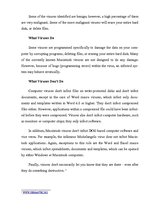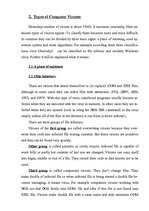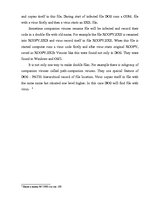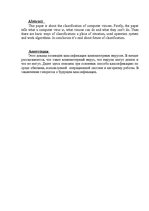-
Computer Virus
| Nr. | Sadaļas nosaukums | Lpp. |
| 1. | What is a computer virus? | |
| 2. | Types of computer viruses. | |
| 2.1 | a place of existence | |
| 2.1.1 | file infectors | |
| 2.1.2 | boot viruses | |
| 2.1.3 | multi-partite viruses | |
| 2.1.4 | macro viruses | |
| 2.2 | used operation system | |
| 2.3 | work algorithms | |
| 3. | Conclusion. |
A virus is a piece of software designed and written to adversely affect your computer by altering the way it works without your knowledge or permission. In more technical terms, a virus is a segment of program code that implants itself to one of your executable files and spreads systematically from one file to another. Computer viruses do not spontaneously generate: They must be written and have a specific purpose. Usually a virus has two distinct functions:
Spreads itself from one file to another without your input or knowledge. Technically, this is known as self-replication and propagation.
Implements the symptom or damage planned by the perpetrator. This could include erasing a disk, corrupting your programs or just creating havoc on your computer. Technically, this is known as the virus payload, which can be benign or malignant at the whim of the virus creator.
A benign virus is one that is designed to do no real damage to your computer. For example, a virus that conceals itself until some predetermined date or time and then does nothing more than display some sort of message is considered benign. …
1. What is computer virus? A virus is a piece of software designed and written to adversely affect your computer by altering the way it works without your knowledge or permission. In more technical terms, a virus is a segment of program code that implants itself to one of your executable files and spreads systematically from one file to another. Computer viruses do not spontaneously generate: They must be written and have a specific purpose. Usually a virus has two distinct functions: • Spreads itself from one file to another without your input or knowl-edge. Technically, this is known as self-replication and propagation. • Implements the symptom or damage planned by the perpetrator. This could include erasing a disk, corrupting your programs or just creating havoc on your computer. Technically, this is known as the virus payload, which can be benign or malignant at the whim of the virus creator. A benign virus is one that is designed to do no real damage to your computer. For example, a virus that conceals itself until some predetermined date or time and then does nothing more than display some sort of message is considered benign.












